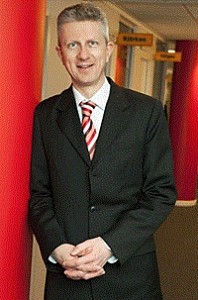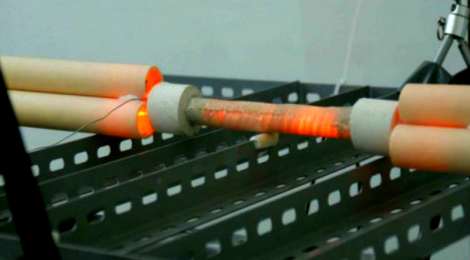
End Of Fossil Fuel Age Nears
Rossi E-CAT 32 day cold fusion test supervised by major European energy research institute Elforsk shows 1400C heat and stunning isotope ratio shifts.
End of fossil fuel age could be very near to hand! Radiation and waste free nuclear power at a cost of just a fraction of 1% of equivalent fossil fuel may save the world.
Andrea Rossi’s E-Cat — a prominent “cold fusion” device has been shown in this second E-Cat report (Oct. 8, 2014) to generate heat energy equivalent to more than 3 times the amount of energy required to power the device. This remarkable finding has been verified by third-party researchers, according to a new 54-page report. The international team of notable professor/researchers observed a small E-Cat over a period of 32 days of operation, where operating at a temperature of between 1260 C and 1400 C it was measured to produce a net energy of 1.5 megawatt-hours, or “far more than can be obtained from any known chemical sources in the small reactor (containing 1 gm of fuel.”

Coefficient of Power Chart from report reveals power produced is more than 3 times the power input. At these levels it is a simple matter to recycle some of the heating power to produce the electrical power to sustain the reactor effectively yielding legendary free energy!
The closely monitored and recorded testing took place in an independent laboratory in Switzerland where the six European scientists conducting the tests had complete control of the experiment but were assisted by its creator A. Rossi.
The actual E-Cat device tested was provided by a US company Industrial Heat of North Carolina (IH) that has acquired a technology license from Rossi is gearing up toward commercialization of the cold fusion technology. It’s clear that IH has been working on the technology as the latest E-CAT is a modified version of Rossi’s previously displayed E-CAT. IH CEO Tom Darden gives his reasons for investing heavily in cold fusion,
“I’m serious — “It’s about air pollution and coal,” Darden says. “Our company is called Industrial Heat. Our job is to make industrial heat and industrial heat is made by coal… We don’t think any energy should be made by coal, so that’s why I’m doing this. This could be a way to eliminate the use of coal.”
The tests were sponsored by the Royal Swedish Academy of Science (home of the Nobel Prize) and Elforsk AB, which is Sweden’s version of the U.S. Electric Power Research Institute who stepped in to supervise the work to reduce concerns about their validity. This second round of testing of the E-CAT was designed to eliminate experimental error and the possibility of claims of fraud that have plagued the field of cold fusion for decades.
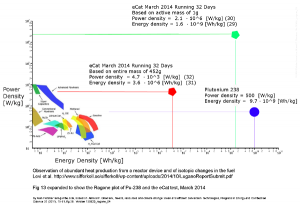
Rangone energy comparison plot showing E-Cat energy realm far beyond chemical energy potential…close to nuclear fission click to enlarge
The researchers naturally were careful to analyze the fuel before and after the 32-day run using several techniques including two different mass spectroscopic methods capable of resolving and defining isotopic ratios in the fuel mix. Enormous changes in the isotope ratios in the spent fuel compared to the virgin fuel could only result from “nuclear reactions” — a finding that should satisfy even the most ardent and dogmatic skeptics.
Energy Too Cheap To Meter Will Begin the End Of Fossil Fuel Age
The Rossi E-Cat and testing is remarkably similar to our own work (read more about hear at atom-ecology) which has shown definitive anomalous heating and profound nuclear isotope production and isotopic ratio shifting. Using a variety of mass spec techniques, we were first to employ TOF-SIMS, we observed dramatic isotope shifts in palladium and neighboring elements.
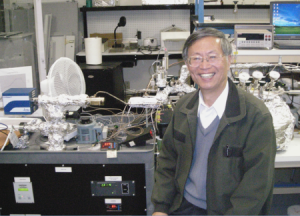
Dr. Xing Zhong Li one of China’s most prominent nuclear experts in my lab in 2005 next to one of our helium mass spectromters, like the one we offered to lend Rossi.
I also employed 7 of the world’s finest helium mass spectrometers we repeatedly observed stunning production of 4He both in our reactor gases and within our reactant metal fuels. Noteworthy in our helium measurements were dramatic shifts in 3He 4He ratios.
A few years ago when we offered to lend Rossi one of our state of the art mass spectrometers to hasten his, now definitive nuclear isotope results.
Andrea graciously declined our offered mass spectrometer saying:
“Dear Russ, I must decline your kind offer as surely you must understand that we are competitors in this work.”
We were not seeking to uncover Andrea’s secrets but rather to lend a hand to advance a remarkable cold fusion design so very similar to our own.
We are now delighted to be among the first to congratulate him on these new findings. As we told Andrea then and we still believe, “a rising Italian cold fusion tide will lift all boats.” We are quite certain having now read the two reports on the E-CAT that simple modifications to our own device designs helped along by some new understandings courtesy of his work will provide us with the ability to make a great leap forward and begin rapid development and manufacture of our own practical clean cold fusion devices producing energy too cheap to meter. For those interested in the details one simple refinement we have found leads to spectacular multiplied efficiency gains is simply providing the power via a rapid duty cycle.
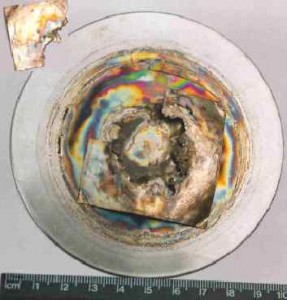
Palladium target foil having melted while in room temperature D2O experiment. Palladium melts at over 1600C! Large amounts of 4He was found in the metal in the vicinity of the hot zone, none was found in metal at the edge of the metal target.
Our work with hydrogen loading of suitable metallic materials has been similarly sponsored and supported by the US Electric Power Research Institute (EPRI) and several other government organizations. This work saw our array of experimental reactor designs studied in multiple supervised third party labs including SRI, Lockheed Palo Alto, Los Alamos National Laboratory, Lawrence Berkeley & Livermore National Labs, NRL, Pacific Northwest National Laboratory, Rockwell, General Atomics, and many others.
While our work those few years ago was proven to be equally proficient in proving production of helium and isotopic shifts in target metals we were isolated and rebuked as “wild-catters” in a world of energy dogma that fears the cold fusion paradigm shift.
Here’s a link to an article in WIRED Magazine from 1998 that featured my success with cold fusion and isotope studies therein.
For Old King Coal and his brethren it’s better to throw the baby out with the bath water than to allow a reshuffling of the world’s energy resource deck with a new source of clean nuclear energy perfectly free of radiation and waste issues and truly “too cheap to meter.” It’s their worst ‘stranded asset’ nightmare, now almost ready for homes and businesses everywhere. It’s nigh time to start selling oil shorts.
First cold fusion products to arrive will likely be small home heating devices that will provide heat and hot water. Those products will likely be priced competitively with common gas or electric heaters but will come with the advantage of the fuel cost to operate them being a tiny fraction of the cost of gas or electricity. Next will be industrial heat and preheat systems that when piggy-backed onto existing industrial heat sources will cut the cost of industrial heat by as much as 80%. District heating as is used in major cities will benefit enormously from this clean industrial energy source. Engineering design and delivery of these scale of devices is just a few years off, certainly within 5 years. Plug and play replacement heat for major electrical generation using fossil and nuclear fuels may take up to 10 years to deploy.
Some might think this ‘cold fusion’ miracle is happening all of a sudden but those of us who remember the work of Martin Fleischmann and Stan Pons who introduced cold fusion to the world in 1989 it’s been a long slow trail of 25 years.
New E-CAT report is widely available on-line.
This new E-CAT report [PDF] on the E-Cat was performed by a team of six (reputable) researchers from Italy and Sweden. The “proof of principal” work was funded by While the new E-Cat looks very different from previous iterations, the researchers say that it uses the same “hydrogen-loaded nickel” and additives (notably the common cold fusion additive lithium) as a fuel. The device’s inventor, Andrea Rossi, claims that the E-Cat uses cold fusion — sometimes referred to as low-energy nuclear reactions, LENR by those afraid of the term cold fusion.
The researchers, analyzing the fuel before and after the 32-day burn, note that there are two remarkable isotope ratio shifts. One shift occurs amongst the 5 stable isotopes of nickel which are confirmed by the researchers to be in their natural ratios in the virgin fuel and shifted to where 62Ni becomes incredibly enriched. The researchers say there is just 1 gram of fuel inside the E-Cat, of that a fraction has been analyzed.
The report states, “The unused fuel shows the natural isotope composition from both SIMS and ICP-MS, i.e. 58Ni (68.1%), 60Ni (26.2%), 61Ni (1.1%), 62Ni (3.6%), and 64Ni (0.9%), whereas the ash composition from SIMS is: 58Ni (0.8.%), 60Ni (0.5%), 61Ni (0%), 62Ni (98.7%), 64Ni (0%), and from ICP-MS: 58Ni (0.8%), 60Ni (0.3%), 61Ni (0%), 62Ni (99.3%), 64Ni (0%). We note that the SIMS and ICP-MS give similar values within the estimated 3% error in the given percentages.”
With regard to Lithium in the reaction the researchers report, “The Lithium content in the fuel is found to have the natural composition, i.e. 6Li@7 % and 7Li@93 %. However at the end of the run a depletion of 7Li in the ash was revealed by both the SIMS and the ICP-MS methods. In the SIMS analysis the 7Li content was only 7.9% and in the ICP-MS analysis it was 42.5 %.” (Ed-note: The difference in percentages between the TOF-SIMs method and ICP-MS method are quite consistent with what those of us working in this field of isotopic ratio measurements would expect.)
Given the tremendous heat output along with these apparent nuclear ash signatures we seem to have definitive proof of bot cold fusion fire and nuclear ash. Enough to satisfy the dogmatic skeptics of 20+ years who have howled that if there is nuclear fire there must be nuclear smoke (ash).
CEO of Elforsk Orders Start Of Comprehensive R&D Program
Elforsk is a cooperative research and development institute that is made up of utilities and other energy companies operating in Sweden. Today on Elforsk’s web site and in the Swedish science and technology magazine Nyteknik, Elforsk’s CEO Magnus Oloffsson has written an article responding to the E-Cat testing report published yesterday by the independent European research team.
Here are some of the key points CEO Oloffson makes:
- Clear isotope changes in the analyzed fuel indicates clear evidence of case of nuclear reactions at low temperatures. It suggests that we may be facing a new way to extract nuclear energy. Probably without ionizing radiation and radioactive waste. The discovery could eventually become very important for the world’s energy supply . . .
- If it is possible to safely achieve and control the now indicated nuclear reactions waiting probably eventually mean a fundamental transformation of our energy system. It can open opportunities for decentralized energy supply. Electricity and heat can then be produced with relatively simple components. Climate Efficient energy would be very cheap. . .
- Elforsk takes now the initiative to build a comprehensive Swedish research initiative. More knowledge is needed to understand and explain. Let us engage more researchers in searching coat phenomenon and then explain how it works.
- This is a rapid response from a serious and influential energy organization to yesterday’s report. Elforsk is now taking LENR very seriously, and it looks like Sweden could be the first country to really get behind an effort to understand and develop this new form of energy. We don’t know what the future plans of Industrial Heat are to make available the E-Cat for further research and development, but in yesterday’s report, the testing team mentioned that they want to continue their work to understand exactly what is going on inside the E-Cat.
Naturally the next step is the reproduction of this work now that Rossi et al have made this revelation and have published a patent application. The teaching in the patent materials is surely sufficient for just about anyone to reproduce this result… see my posting Patents Must Teach.
Stay tuned over the course of the next while we will be reporting more on the world of cold fusion and the long overdue end of fossil fuel age. In the presence of the almost infinite abundance of internet trolls and gadflys posting on this topic we recommend paying attention to the few real cold fusion experimentalists, they are not so hard to find.
